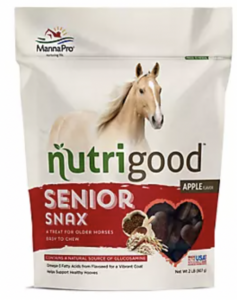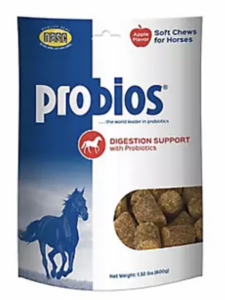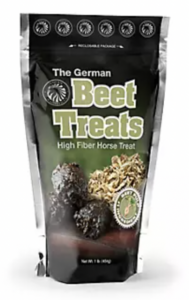Horse News
Member
Trick for Treat!
As a child, I never visited my pony without a packet of peppermints in my pocket, but as I grew older, I backed off the idea of feeding treats. I didn’t like my horse frisking me every time he saw me and decided a nice scratch was just as good a reward as something edible.
Things changed when I discovered the importance of positive reinforcement training. I had a young mare I was training, and she was reluctant to leave the yard alone. Using clicker training and carrot chunks, I persuaded her that the outside world wasn’t as scary as she thought.
Read on for our favorite horse training treats of all time!
Treat Training for Horses
Most horse owners like to treat their horses from time to time, whether it’s offering treats inside boredom-busting pasture toys or ending a good ride with a few minutes of quality grazing time.
If you’re using treats to train your horse, certain options are simply not feasible. You can’t walk around with soggy beet pulp mash in your pockets or offer your horse a Kong as a reward for taking a step backward.
When using horse treats for training, you need something convenient to carry and bite-sized.
As you may need to reward your horse repeatedly during a 30-minute training session, you must also ensure your treats are reasonably healthy and nutritious.
Positive Reinforcement
Using treats with a positive reinforcement training session takes considerable practice, especially if you’re using a clicker.
I found it extremely difficult to wrestle a piece of carrot from my treat pouch while managing the precise timing needed to press the clicker, all while keeping an eye on my overeager horse.
This problem is perhaps why many professional trainers warn against treat training for horses.
Nevertheless, eating stimulates the horse’s parasympathetic nervous system, enabling them to relax and digest.
This reaction is what makes positive reinforcement training so effective. As the horse relaxes, its flight reflex diminishes, making it more receptive to the lesson.
Top Ten Treats for Training Horses
| Treat | Price Point | Pro | Con |
| Apples | $ | Low sugar content; appetizing to most horses | Easily bruised, will spoil |
| Carrots | $ | High in fiber and essential nutrients | Limited shelf life |
| Peppermints | $$ | Horses love them, and they don’t contain any toxins | High sugar content |
| Minty Muffins | $$$$ | Flavorful and packed with vitamins | Tend to stick together in a minty mess in hot weather |
| Nutrigood Senior Snax Horse Treats | $$ | Ideal for overweight and senior horses | They don’t appeal to all horses |
| Manna Pro Bite-Sized Nuggets | $$$ | Bite-sized, nutritious, and easy to store | Higher price range |
| Mrs. Pastures Horse Cookies | $$ | All natural ingredients, firm texture | Too hard for some horses to chew comfortably |
| Probios Horse Soft Chews | $$$ | Promote healthy digestion and reduce stress | Should only be fed in small quantities |
| Purina Carrot and Oat Flavored Horse Treats | $$$ | Perfect size with good nutritional value | Limited shelf life |
| German Beet Treats | $$$ | Natural ingredients and easily digestible | Treats need to be broken into smaller pieces if used as training treats |
Treat Recommendations
Apples
Apples are healthy and have nearly universal appeal.
Few horses turn their noses up at an offering of apples, and you can cut them into bite-sized pieces to make them more convenient for training.
PROS:
- Healthy
- Low in sugar
- Relatively easy to find
- Appetizing to most horses
CONS:
- Limited shelf life
- Bruise easily
Carrots
Carrots are high in fiber and low in sugar. Like apples, they’re loved by most horses but don’t bruise as easily.
You should chop your carrots into strips rather than circles to minimize the risk of choking.
PROS:
- High in fiber
- Convenient
- Affordable
CONS:
- May cause colic if fed in excess
- Too hard for some senior horses to chew
Peppermints
Many horses love peppermints, and it’s good for their digestive systems. Peppermints are also easy to keep in your pocket, although they do get sticky in hot weather.
Although they don’t contain a lot of sugar, the sugar content of the average peppermint is enough to cause problems for an obese horse or one suffering from insulin resistance.
You should only feed peppermints in moderation, which means no more than four mints per day. This limit makes them unsuitable for training when you may need 20 or more treats to achieve your goal.

Click to see them at Amazon

- Bite-sized
- Good for the digestive system
- Appetizing
CONS:
- High in sugar
- Should only be fed in moderation
Buy these treats at Amazon
Minty Muffins
These tasty treats contain only natural ingredients, making them safe and healthy for your horse to eat. You might even be tempted to try one yourself!
They are quite large, so they could take a while for your horse to polish off.
This means they’re not ideal for training purposes unless you want to give your horse a big reward for completing a particularly complex task. The higher price tag on these might also encourage you to keep these for special occasions!

Click to see it at Amazon

- Natural and healthy
- Extremely tasty!
CONS:
- Too large for most training situations
- Higher price range
Buy these treats at Amazon
Nutrigood Senior Snax
These nutritional snacks are crunchy yet soft enough for a senior horse to enjoy. They’re also small enough to fit a handful into your pocket.
They contain glucosamine to support your horse’s joints and biotin for their hooves, making them ideal for older horses.

Click to see it at State Line Tack
PROS:
- Designed for senior horses
- Convenient size and shape
- Provide nutritional support for joints and hooves
CONS:
- Not all horses enjoy the taste
- Higher price range
Buy these treats at State Line Tack
Manna Pro Bite-Sized Nuggets
These tasty pocket-sized treats come with a great incentive—if your horse doesn’t like them, the company will refund your purchase in full! It probably won’t come to that, though, as these peppermint-flavored nuggets seem irresistible to most equines.
They are specifically designed to use as rewards when training or stretching your horse.
They’re also affordable (although not as cheap as carrots) and have a long shelf-life.

Click to see it at Amazon

- Pocket-sized treats
- Appetizing
- Good nutritional profile
CONS:
- Only available in small packets
Buy these treats at Amazon
Mrs. Pastures Horse Cookies
These crunchy cookies are the perfect size to use as training treats. Not only that, but they’re also packed with healthy ingredients like oats, barley, and apple and contain no preservatives or other additives.
They’ve been dehydrated so that they’re nice and hard and won’t fall apart in your pocket.
Unfortunately, that also means they might be a bit too hard for older horses to enjoy comfortably!

Click to see it at Amazon

- Perfect size for training
- No preservatives or additives
- Contain healthy, natural ingredients
CONS:
- Not suitable for older horses or those with dental issues
Buy these treats at Amazon
Probios Horse Soft Chews
If your horse can’t cope with the texture of Mrs. Pastures Horse Cookies, why not try these soft, chewy treats instead? They are highly palatable and contain naturally occurring microorganisms that will give your horse’s digestive system a boost.
They also help reduce stress, making them ideal treats for traveling, vet visits, and farrier appointments.

Click to see it at State Line Tack
PROS:
- Good for the digestive system
- Suitable for older horses and those with dental issues
- Contain healthy, natural ingredients
CONS:
- Should only be fed in moderation
Buy these treats at State Line Tack
Purina Carrot and Oat Treats
Even the pickiest of horses will enjoy these bite-sized treats and they’re the perfect size and texture to use in your training sessions.
They are hard enough not to disintegrate in your pocket but soft enough for most horses to chew comfortably.
In addition to the oats and carrots, these healthy horse treats contain vital vitamins and minerals, including calcium, vitamin A, and selenium.

Click to see it at Amazon

- Perfect size and texture for training
- Packed with vitamins and minerals
- Nutritionally designed to complement any horse feed
CONS:
- Some older horses may find them too tough
Buy these treats at Amazon
German Beet Treats
These high-fiber treats are free of artificial colors, flavoring, and preservatives and contain mainly beet pulp, which is high in calories, but low in both starch and sugar.
These are some of the few treats you can safely feed overweight horses and those suffering from insulin resistance.
Unfortunately, they’re also a little bigger than bite-sized, so you might want to break them in half if you’re using them for clicker training.

Click to see it at State Line Tack
PROS:
- High-fiber treats
- Low in sugar and starch
- Suitable for most horses
CONS:
- Not the #1 choice for clicker training
Buy these treats at State Line Tack
When to Treat
When you’re training a horse, you need to tie the reward (cookie) to the behavior at the precise moment your horse performs the behavior requested of him.
For instance, if you ask a horse to move over by applying pressure to his shoulder, you should offer the treat the moment he begins to move in the desired direction.
Treating at the wrong time can reinforce undesirable behavior and cause bad habits to develop.
Similarly, treating too frequently with unhealthy rewards can exacerbate health conditions such as obesity and equine metabolic syndrome.
Some riders opt to simply treat at the end of a good ride as a reward for a job well done. No matter your treat training strategy, you need a safe, healthy, convenient treat to offer your horse.
Treat Considerations
There’s no point in giving your horse a treat that he doesn’t find appetizing—it’s just a waste of time and money!
Nutritional Value
Horse treats need to be palatable but healthy, especially if you’re using them for positive reinforcement training and need a constant supply.
The best treats are those that have the smallest impact on your horse’s diet. They are low in sugar and calories and high in fiber, vitamins, and other essential minerals.
Convenience
The best horse treats for training are those that fit into your pocket or training pouch. Ideally, they should be hard enough that they won’t crumble, but soft enough that a horse can polish one off in less than a minute.
Treats that are too large and need to be broken into pieces are less convenient than bite-sized treats, and anything remotely sticky will just make a mess!
Shelf Life
Apples and carrots make great horse treats, but they don’t last long. If you can only train once or twice a week, you might be more motivated to find a treat that can keep for several months.
Storage
Many horse riders leave containers of treats in their horse boxes, as well as in a tack or feed room, so they can grab them quickly when they need them. You can’t do this with a treat that needs refrigerating. The best treats are those that will last for several months in an airtight container.
Use caution when storing treats to ensure mice or other rodents can’t access them.
Moderation
Everything in moderation certainly applies to treating your horse. Many things, including apples and carrots, are healthy in small doses but can cause digestive upset or even colic in large amounts.
Safety
Watch your fingers! Always use caution when feeding horses and hold your hand flat with the treat in your palm. Some owners opt to feed treats out of a bucket or feed pan to avoid encouraging nippy behavior.
Frequently Asked Questions
Q: What are the best horse treats? (We asked a horse!)
According to my horse, the best horse treats are carrots and apples, but she’s a bit of a traditionalist. For a senior horse, I’d recommend Nutrigood Senior Snax Horse Treats, but for training purposes, Manna Pro’s Bite-Sized Nuggets take the biscuit (so to speak)!
Q: What are the best horse treats for horses with Cushing’s?
Never give a horse with Cushing’s disease or PPID treats that have a high sugar or starch content because they’re prone to insulin resistance and high blood sugar levels. Even apples and carrots contain too much sugar for horses with Cushing’s, although apple peels are safe because they contain very little sugar and are a good source of fiber.
Zero-sugar treats like Probios’s Horse Soft Chews, and German Beet Treats are suitable for horses with Cushing’s, while Nutrigood’s Senior Snax are fine in moderation as they only contain a small quantity of brown sugar. Other zero-sugar treats include hay cubes and hay pellets, although we always recommend soaking these products before feeding to reduce the risk of choke or impaction colic.
Q: What are the best horse treats for horses with ulcers?
Probios’s Horse Soft Chews are suitable for horses with ulcers and other digestive issues, as are high-fiber hay cubes, but your choices are pretty limited. You could also try making your own horse treats using recipes like this one.
Q: What can I use for horse treats?
You can use your horse’s concentrate or simple hay pellets as a horse treat if you’ve nothing else to hand. Even a peppermint will do if you just want to say a quick thank you, although you should be careful about feeding your horse too many. If you have absolutely nothing food-related available, try a good old scratch—sometimes, there’s nothing a horse likes more!
Q: What are the best treats for horse training?
I still maintain that chopped-up carrots are the best treats for horse training. They’re affordable enough that it doesn’t matter how many your horse chomps through in a session and tasty enough that he feels rewarded. You can also carry carrot pieces around in your pocket without them going especially sticky or soft.
Parting Thoughts
Horse treats are a great way to show your horse how much you care and reward him for good behavior. The best treats for training are small enough to fit in your pocket and healthy enough that it doesn’t matter if it takes 20 or more treats to achieve your goal.
As a rule, you should steer clear of treats with a high sugar or starch content as this can interfere with your horse’s digestive system and disrupt his daily nutritional intake.
Whether you opt for apples and carrots, or commercial horse treats, it’s critical that you only feed them to your horse in moderation. Too many treats can exacerbate conditions like insulin resistance and obesity and encourage undesirable behavior like nipping.
P.S. Enjoy this article? Trot on over to:
- Seven Boredom Bustin’ Horse Pasture Toys
- Snacking Success: How to Feed a Horse an Apple
- Meet Your Horse’s New Bestie: Companion Animals 101
- Horse Care for the Total Beginner: You CAN Do This!
- Stay Put, Pony! Horse Stall Guards for Beginners
- 13 Best Toys and Treats for Busy-Minded Donkeys
- Home Sweet Stable: How Big Should a Horse Stall Be?
Further Reading
https:// www.horseillustrated.com/healthy-horse-treat-recipe
The post 10 Top Treats for Training Horses “The Nice Way” appeared first on Horse Rookie.
Continue reading...
